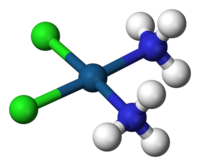
Photo from wikipedia
Abstract The synthesis and characterization of the hexanuclear [M 2 (κ O- O 2 CFc) 2 ( µ -O 2 CFc) 2 ( µ -H 2 O)(κ 2 N,N′ -tmeda)… Click to show full abstract
Abstract The synthesis and characterization of the hexanuclear [M 2 (κ O- O 2 CFc) 2 ( µ -O 2 CFc) 2 ( µ -H 2 O)(κ 2 N,N′ -tmeda) 2 ] (M II = Ni, 5 ; Co, 6 ; Fc = ferrocenyl, ( η 5 -C 5 H 4 )( η 5 -C 5 H 5 )Fe; tmeda = N,N,N′,N′ -tetramethylethylendiamine) and the trinuclear [Cu(κ 2 N,N′- tmeda)(κ 2 O,O′- O 2 CFc) 2 2 ] ( 7 ) coordination compounds are described. Compounds 5 – 7 were prepared by the consecutive reaction of ferrocene carboxylic acid (FcCO 2 H; 1 ) with [ n Bu 4 N]OH followed by treatment of in situ formed [ n Bu 4 N][FcCO 2 ] with the metal salts [M(tmeda)(NO 3 ) 2 ] (M = Ni, 2 ; Co, 3 ; Cu, 4 ). The structures of 5 – 7 in the solid state were determined by single crystal X-ray diffraction analysis. Isostructural 5 and 6 crystallise in the triclinic P 1 ¯ ( 5 ) and in the monoclinic space group P 2 1 /n ( 6 ). The two M II (tmeda) entities of 5 and 6 with M II = Ni, Co, respectively, are syn , syn -bridged by two FcCO 2 − functionalities and one µ -bridging water molecule. Additionally, two FcCO 2 − ligands are κ O -coordinated to each M II ion to form octahedral MN 2 O 4 coordination setups. A related MN 2 O 4 coordination setup is observed for 7 as well, whereby the Cu II ion is coordinated by two O 2 CFc and one tmeda ligand. Electrochemical investigations reveal that all individual Fc units of 5 – 7 are oxidized separately. Thermogravimetric analysis showed that 5 and 6 start to decompose at 110 and 125 °C and thus at significantly lower temperatures compared to 7 (200 °C). The mass residues obtained after decomposition are composed of Fe 2 O 3 , FeNi 3 and Fe 0.64 Ni = Ni 0.36 ( 5 ), Fe and Co 3 O 4 ( 6 ) and Cu 2 O and CuFeO 2 ( 7 ), as determined by powder X-ray diffraction analysis (PXRD). Thermal susceptibility measurements of 5 and 6 determined a weak antiferromagnetic coupling in 5 and 6 with J = 1.1 K and J = 1.9 K, respectively.
Journal Title: Polyhedron
Year Published: 2017
Link to full text (if available)
Share on Social Media: Sign Up to like & get
recommendations!